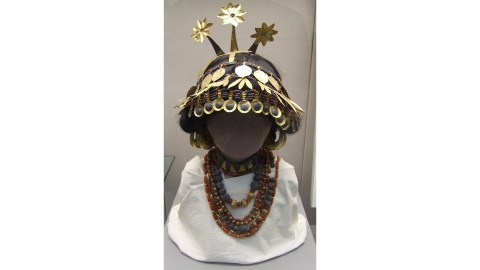The Glam-Ur-ous Life: Archaeology and Modern Art

When British archaeologist Leonard Woolley discovered in December 1927 the tomb of Puabi, the queen/priestess of the Sumerian city of Ur during the First Dynasty of Ur more than 4,000 years ago, the story rivaled that of Howard Carter’s discovery of Tutankhamun‘s tomb in Egypt just five years earlier. “Magnificent with jewels,” as Woolley described it, Puabi’s tomb contained the bodies of dozens of attendants killed to accompany her in the afterlife — the ideal material for a headline-grabbing PR campaign that momentarily shouldered Tut out of the spotlight. A new exhibit at New York’s The Institute for the Study of the Ancient World titled From Ancient to Modern: Archaeology and Aesthetics puts Puabi back in the spotlight to examine how archaeology and aesthetics intersected, transforming ancient art into modern and making modern art strive to be ancient.
As Jennifer Y. Chi (chief curator at the ISAW) and Pedro Azara explain in their catalog essay, “Archaeology and Aesthetics is the first U.S. exhibition to include a fascinating mixture of Early Mesopotamian art from iconic archaeological sites, as well as a rich grouping of archival material, alongside modern and contemporary works of art.” The exhibition “presents the ‘biography’ of objects, illustrating their discovery and transformation, be it into a virtuoso work of art, a cultural symbol, or a popular icon.” Chi and Azara’s punning “Glam-Ur-Ous” captures the project’s mission in one perfect portmanteau by mashing together the ancient Ur with the modern idea of glamour to achieve the synthesis we know today — a non-neutral appreciation of ancient objects for modern meaning.
When Woolley’s team first discovered Puabi’s tomb they marveled at the wonders left untouched by tomb raiders for millennia, but also despaired at the collapsed ceiling that crushed many of those same remains, including Puabi’s skull and the elaborate golden headdress surrounding it. Woolley’s wife and fellow archaeologist, Katharine Woolley, took up the challenge of reconstructing the golden headpiece. A fashionista of the time, Katharine borrowed (consciously or unconsciously) from the fashions of her time, coming up with a headpiece similar to the trendy creations of designer Paul Poiret (shown above). Thus, ancient Ur met the Jazz age.
Not only did Puabi’s accessories get a modern update, but also Puabi herself became the recipient of a modern makeover when curators “recreated” her face and she ended up looking like Greta Garbo, the most beautiful woman in the world circa 1928. Kim Benzel cautions in the catalog of the dangers of this updating: “Is not every discussion about the image of Puabi, in whatever form one wishes to accept that image, ignoring that we, the discussants, are removing her from her original context? That is, are we not exposing an image that was in all likelihood never meant to be seen, or whose power lay not in the literal seeing of it?” Ancient Ur buried Puabi and her riches for a reason beyond simple mortality, but the “second life” modernity’s given her, no matter how “glam-ur-ous” bears little to no resemblance to the original reality or even intended fantasy.
The show shifts quickly from archaeology to aesthetics when modern artists come into play. Until the mid-19th century, little to nothing was known of ancient Sumerian culture. Ancient Egypt, Greece, and Rome dominated not just archaeology, but also the popular imagination’s concept of the ancient “other.” Just as African art provided a model of the “primitive” for Picasso and others to incorporate into their art, the discovery and display of Sumerian works such as those of Puabi’s tomb served as a fruitful example of “primitive” art ripe for modern appropriation. “The ‘primitive’ as such was a collection of visual attributes construed by the West as universally characteristic of primal artistic expression,” Jack D.M. Green and Jean M. Evans explain in the catalog. “The result was a blank slate onto which Western meanings and perceptions were projected, fantasized, and realized.” Just when modern artists looked for the next new thing free of the taint of tradition, they surprisingly found it in 4,000-year-old artifacts.
Works by Henry Moore, Alberto Giacometti, and Willem de Kooning in the exhibition clearly show the influence of Sumerian art on their modern art. For Moore, freshly self-exiled from his academic training, Sumerian sculpture such as the Diyala statuettes seemed “the simplicity and expression of life … [whose] austere heads and hands were a sign of true humanity,” argue Chi and Azara. Giacometti, however, “created a series of drawings that embraced the image of Gudea, emphasizing the geometric patterns that structured the sculpture.” Finally, de Kooning, after studying the Tell Asmar statuettes, painted his controversial Woman series, with the “strong frontality and … wide, staring, hypnotic eyes that are so intimately connected with Sumerian sculpture.” Placed side by side (as the exhibit and well-illustrated catalog do well), the ancient and modern works clearly speak to one another — a dialogue in which each side shapes the other.
The show’s final shift is, as Green and Evans describe it, “from aesthetics to politics.” If the 20th century looked to Sumerian art for inspiration, Sumerian art looks to the 21st century for survival. The ravages of war still threaten archaeological sites and cultural institutions in the Middle East. Contemporary artists such as Iraqi-Irish Jananne al-Ani and Jewish-Iraqi Michael Rakowitz close out the show with their works that document both the destruction of this heritage as well as the “ontological metamorphosis” in which the West has embraced elements of the art, but not always the living inheritors of that same tradition. Rakowitz’s colorful contemporary, Sumerian-style sculptures composed of modern advertising comment forcefully on this paradox.
“Just as they are transformed by our perception,” Chi and Azara write of the ancient works in the show, “may we be able to bear their scrutinizing eyes, which change us too by letting us discover a new world and new meanings for already known worlds.” From Ancient to Modern: Archaeology and Aesthetics wonderfully reminds us that we can never know something in a vacuum. We always bring our own interests and desires to the table. The key lies in recognizing bias to turn it into a strength rather than a blindness. Puabi probably didn’t look like Garbo, but there’s no harm in swapping iconic beauties as long as we know that’s what we’re doing. If you’ve ever wanted to understand the fascination of ancient art and archaeology, From Ancient to Modern: Archaeology and Aesthetics is the perfect spot to start digging.
[Image: Puabi’s reconstructed headgear. Image source:Wikipedia.]
[Many thanks to Princeton University Press for providing me with a review copy of From Ancient to Modern: Archaeology and Aesthetics, edited by Jennifer Y. Chi and Pedro Azara.]
[Many thanks to The Institute for the Study of the Ancient World for providing me with press materials for the exhibition From Ancient to Modern: Archaeology and Aesthetics, which runs through June 7, 2015.]
[Please follow me on Twitter (@BobDPictureThis) and Facebook (Art Blog By Bob) for more art news and views.]




